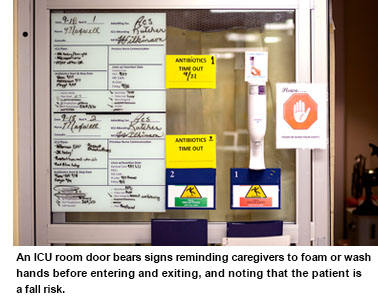A Temporary Setback
Good morning!
On Thursday, the Leapfrog Group, a private hospital ratings group, released its fall scores for the nation’s hospitals, assigning letter grades on overall performance factors that can potentially result in patient harm.
 Leapfrog gave the Medical Center a “D” grade, a disappointment after hard work on the part of many people to boost the letter grade to a “C” earlier this year.
Leapfrog gave the Medical Center a “D” grade, a disappointment after hard work on the part of many people to boost the letter grade to a “C” earlier this year.
Although doing it stings, owning that grade is the responsibility of all of us - not just the front-line caregivers. While recognizing much progress has been made, we must be accountable for the setback that we will strive to make temporary.
Quality and patient safety are our paramount goals. As the state’s academic medical center and safety net hospital that provides the most advanced services and care for the sickest of the sick, we must be unwavering in our daily actions that keep patients from suffering harm.
The latest score doesn’t negate the fact that we have taken significant strides, and made real progress, toward keeping our patients safe. During the last two years, our overall improvement in clinical care has been updated monthly with real-time metrics. However, while UMMC has shown improvement in its internal data, it’s now important to pay attention to external data and benchmarks as well.
You can track our progress internally on the quality scorecard found on the left-hand side of the Clinical Intranet.
For example:
- Hospital-acquired infections are down 60 percent.
- Complications are down 80 percent.
- 30-day readmissions are some of the lowest in Mississippi.
- 30-day hospital mortality is falling.
But externally, by Leapfrog’s measurements, we’re still a very public “D.” UMMC Grenada’s score rose from an “F” to a “D.”
Leapfrog selects a panel of safety experts, most of them physicians, from across the country to develop a scoring methodology for the letter grades it delivers twice annually. The group bases its ratings on a total of 28 metrics. Twenty focus on safety and use publicly reported data from the Centers for Medicare and Medicaid Services.
A number of national hospital organizations are critical of how Leapfrog and CMS determine scores and ratings. They believe the two don’t adequately adjust for the demographic challenges faced by UMMC and other academic medical centers serving as caregivers for large numbers of the sickest patients and the economically disadvantaged.
Leapfrog uses data that’s up to three years old, meaning the latest score doesn’t reflect significant gains in some of the areas graded. The data include patient safety indicators such as complications after surgery, pressure ulcers, rates of hospital-acquired infection and systems in place to prevent them. Other metrics are based on non-safety processes, such as how patients rate their experience.
Leapfrog takes the data from the 80-plus metrics that hospitals must report that are published on CMS’ Hospital Compare website.
UMMC’s numeric score fell from 2.5968 to 2.4827 on a 4-point scale, 0.019 away from a “C.” One of the reasons for this score is process deficiencies in standardization of the documentation and coding of the care patients receive. These activities provide the data source upon which subsequent determinations about clinical quality and reimbursement are made.
Physicians and coders need to work together and communicate to ensure that patients' disease severity and the care given to them are recorded accurately. While clinical safety has improved significantly, a focus for ongoing work entails providers and coders enhancing accuracy and timeliness in recording this to the benefit of not only quality metrics, but also financial performance.
One example of why it’s important to get this right: If a patient arrives at the Medical Center with a reportable complication, but it’s incorrectly documented and coded that the complication originated in the hospital, it counts against the Medical Center on its safety scores.
The Medical Center is focused also on doing a better job of mirroring the expectations for the nation’s top-tier hospitals when it comes to 24/7 staffing of intensive care units by attending physicians, one of the metrics considered by Leapfrog. I’ve asked Dr. Alan Jones, chair of the Department of Emergency Medicine, and Jason Zimmerman, who recently assumed the new role of associate chief nursing officer of Adult Services, to take on the challenge of organizing and directing a critical care initiative regarding the organizational structure and operations of the critical care tower. Their work will help us move toward a patient-centered model of high quality clinical care as expeditiously as is needed.
In our journey to consistently deliver the safest and highest quality care, our commitment to transparency and accountability to our patients and the public hasn’t wavered. Our quality and safety measures, updated quarterly, can be viewed externally, allowing anyone to see how well we are doing in averting hospital acquired infections or other adverse complications a patient can suffer while in our care.
Let’s celebrate our achievement and successes - we have made real progress - but also continue the work. It’s not just about the letter grade. It’s about the patients we serve, every day, as we pursue our goal of A Healthier Mississippi.



